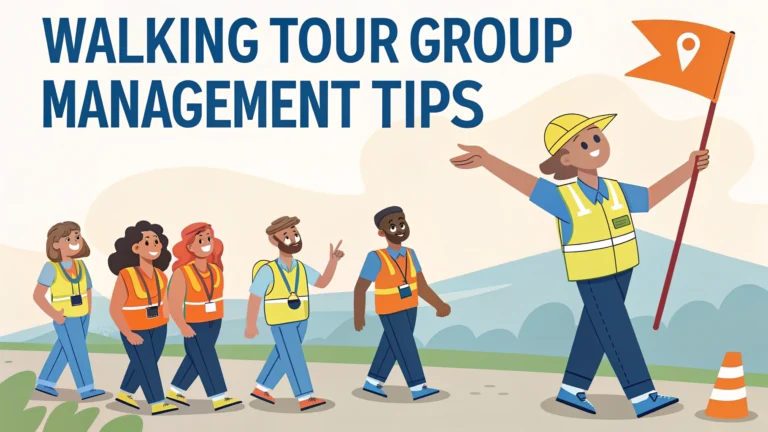Leading walking tour groups requires careful planning, clear communication, and attention to safety protocols – this guide covers proven strategies for successful tour management.
Pre-Tour Planning
- Research routes thoroughly and walk them personally before bringing groups
- Check weather forecasts and plan alternate indoor stops if needed
- Prepare handouts or digital materials with maps and key information
- Have a contingency plan for emergencies and unexpected situations
Safety First
Always carry a first aid kit, emergency contact numbers, and portable phone charger.
Scout safe crossing points and rest stops along the route ahead of time.
Brief participants about safety guidelines and meeting points before starting.
Group Management Tips
- Size Control: Keep groups between 8-15 people for optimal management
- Pace Setting: Walk at the speed of the slowest person
- Position: Lead from the front but regularly check the back of the group
- Communication: Use a microphone system for larger groups
Equipment Checklist
| Essential Items | Optional but Recommended |
|---|---|
| First aid kit | Portable speaker/microphone |
| Water | Umbrellas for guests |
| Maps | Camera |
| Emergency contacts | Spare batteries |
Time Management
Schedule regular breaks every 30-45 minutes, especially for longer tours.
Build in buffer time for photos, questions, and unexpected delays.
Engagement Techniques
- Use storytelling to make historical facts more interesting
- Encourage questions and group participation
- Point out photo opportunities and interesting details
- Share local insights and lesser-known facts
Problem-Solving Strategies
Keep contact information for local taxis and medical facilities readily available.
Have a plan for handling stragglers or participants who want to leave early.
Post-Tour Best Practices
- Collect feedback for continuous improvement
- Document any incidents or issues
- Update route information based on experience
- Follow up with thank-you messages to participants
Remember to check current local regulations regarding group sizes and tour guide licensing requirements in your area.
Marketing and Promotion
- Develop compelling tour descriptions for online platforms
- Use high-quality photos from previous tours
- Encourage reviews and testimonials
- Partner with local hotels and tourism offices
Special Considerations
Weather Adaptations
Have indoor alternatives mapped out for extreme weather conditions. Provide clear cancellation policies and weather-related guidance to participants.
Accessibility
Clearly communicate route difficulty, stairs, and terrain challenges. Maintain alternate accessible routes where possible.
Customer Service Excellence
- Address individual needs while maintaining group momentum
- Handle complaints professionally and promptly
- Create memorable moments through personalized attention
- Maintain professional appearance and demeanor
Documentation Requirements
| Required Documents | Purpose |
|---|---|
| Insurance certificates | Liability protection |
| Permits | Legal compliance |
| Emergency procedures | Safety protocols |
| Participant waivers | Legal protection |
Conclusion
Successful walking tour management combines thorough preparation, safety consciousness, and engaging presentation skills. Regular evaluation and adaptation of procedures ensure continuous improvement and participant satisfaction. Stay informed about industry best practices and maintain all necessary certifications to deliver professional, memorable experiences.
Implement these guidelines systematically and adapt them to your specific tour context for optimal results. Remember that the key to long-term success lies in maintaining high standards while creating unique, engaging experiences for participants.
FAQs
- What is the ideal size for a walking tour group?
The ideal walking tour group size is between 12-15 people. This number allows for good group dynamics while ensuring everyone can hear the guide and move efficiently between locations. - How should I prepare my walking route to accommodate different fitness levels?
Plan routes with regular rest stops every 15-20 minutes, avoid steep inclines where possible, and include alternative shorter routes for those who may need them. Always indicate the difficulty level and total distance in advance. - What essential safety measures should be in place for walking tours?
Have a first aid kit, emergency contact list, clear meeting points, high-visibility vests for guides, and ensure all participants have the guide’s contact information. Check weather conditions before starting and have wet weather contingency plans. - How far should a typical walking tour cover in distance?
A comfortable walking tour typically covers 2-3 miles (3-5 kilometers) over 2-3 hours. This allows for stops at points of interest and maintains an engaging pace without exhausting participants. - What is the best way to handle stragglers in a walking tour group?
Assign a rear guide or sweeper to maintain contact with slower walkers, use regular headcounts at stopping points, and establish clear protocols for regrouping at designated locations. - How often should breaks be scheduled during a walking tour?
Schedule 5-10 minute breaks every 30-45 minutes of walking, with longer 15-minute breaks every 90 minutes. Always ensure restroom facilities are available at some stopping points. - What equipment should tour guides carry during walking tours?
Guides should carry a portable microphone/speaker system, first aid kit, city maps, spare water, umbrella, and a smartphone with emergency contacts and GPS navigation. - How can you make self-guided walking tours more engaging?
Provide detailed maps with numbered stops, include historical photos, create downloadable audio guides, and offer QR codes at key locations for additional multimedia content. - What contingency plans should be in place for bad weather?
Have indoor alternate routes planned, provide clear cancellation policies, know locations of nearby shelters or indoor attractions, and maintain flexible scheduling options. - How can you effectively manage time during a walking tour?
Calculate walking times between stops accurately, limit talks at each stop to 5-7 minutes, build in buffer time for unexpected delays, and use time management apps to track progress.








